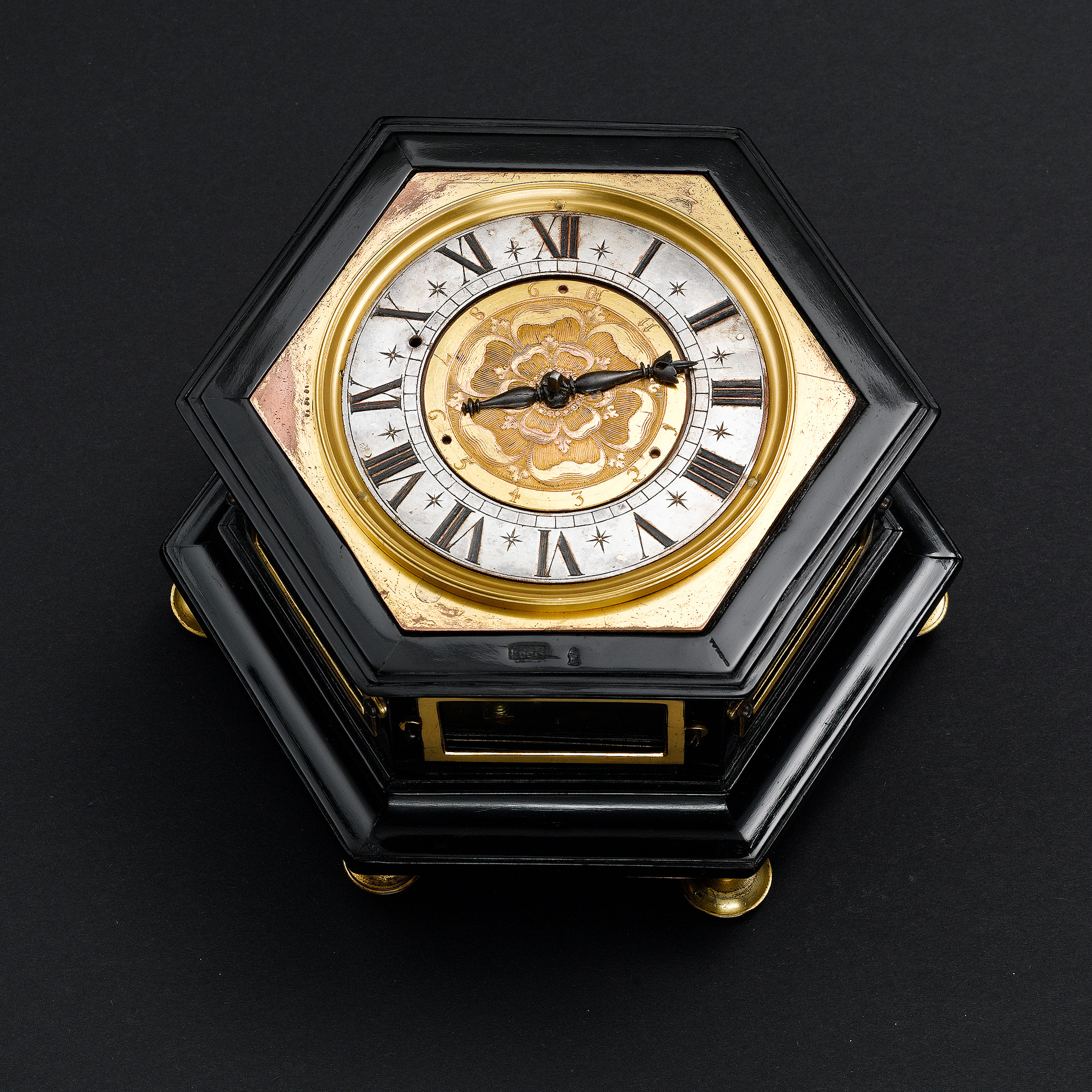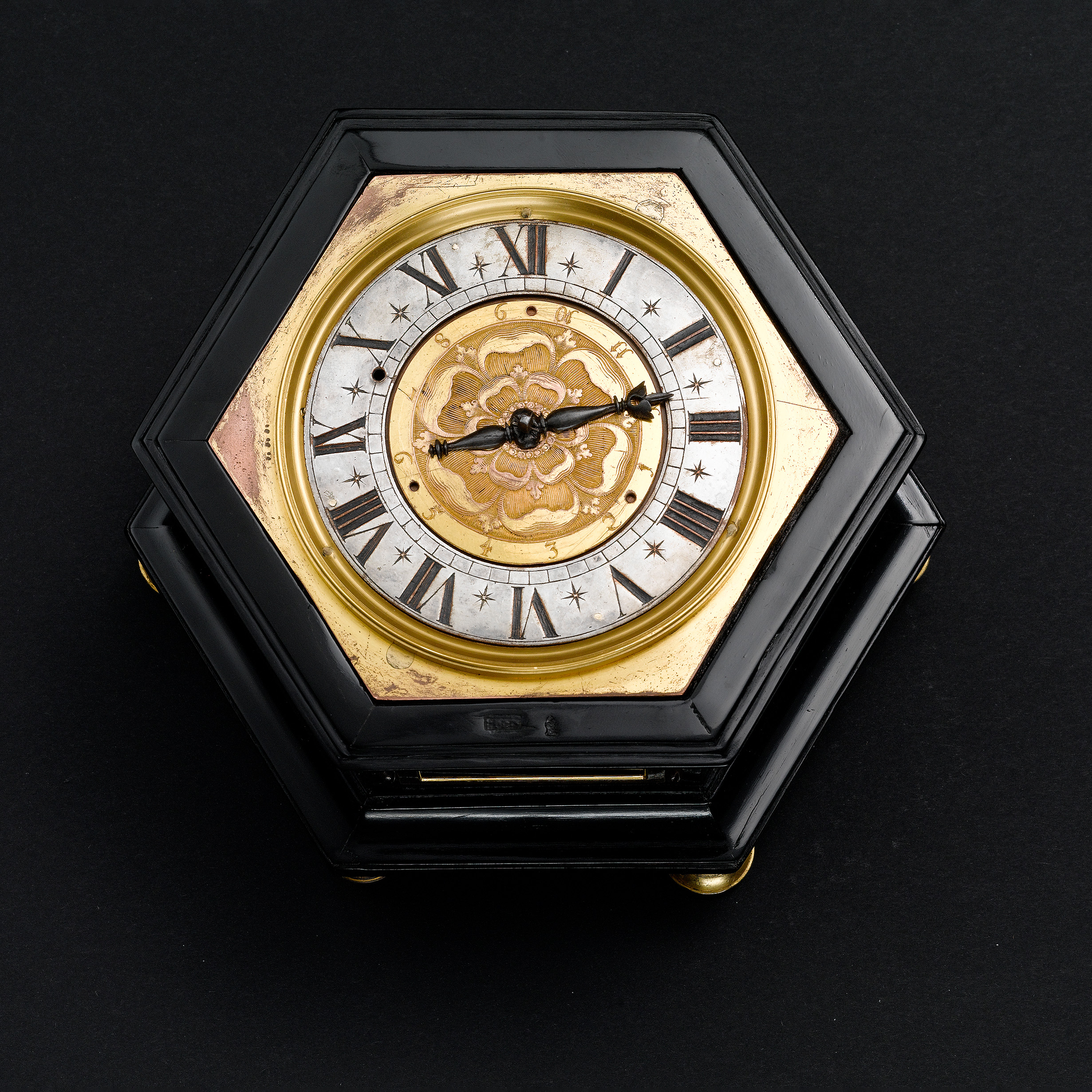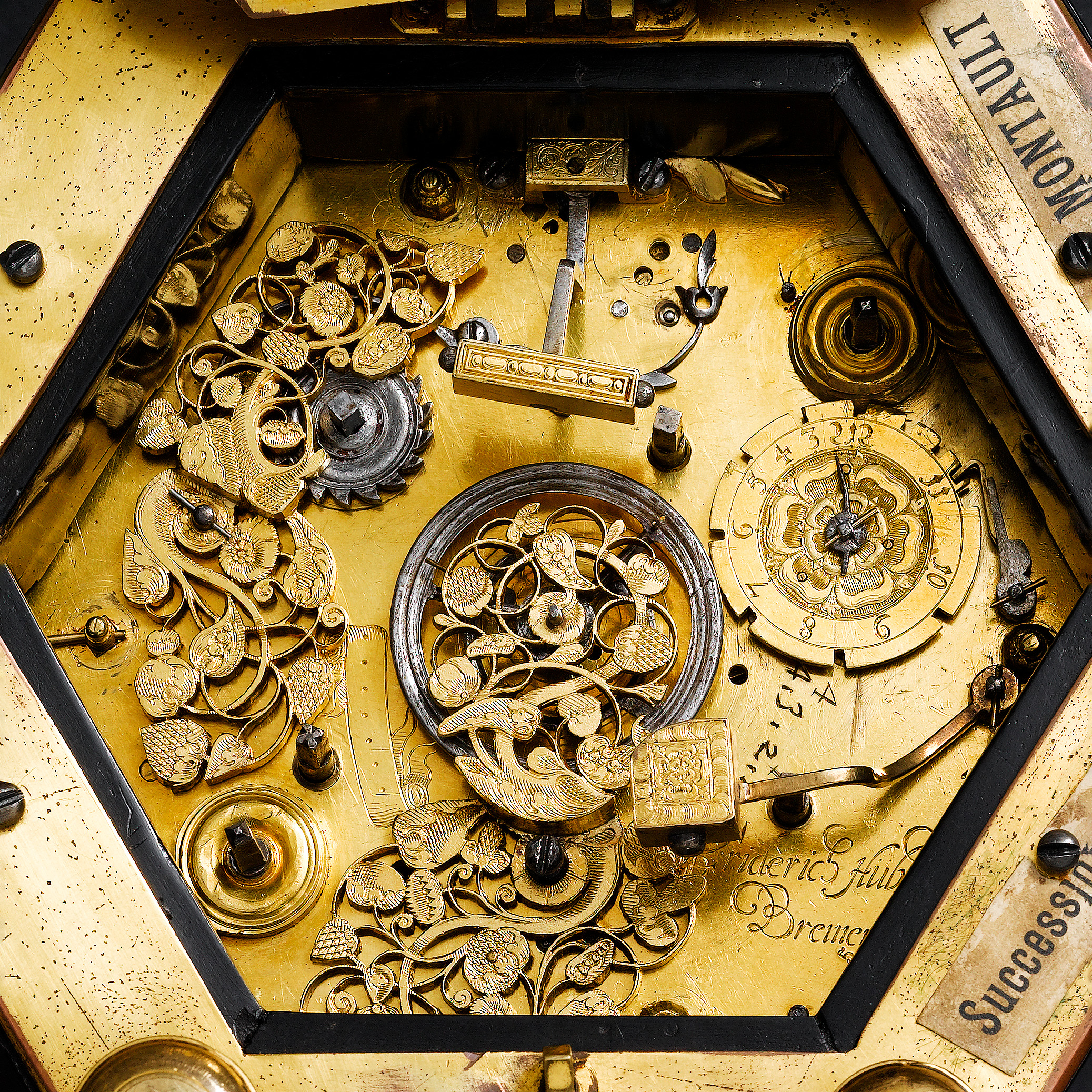Horizontal Table Clock
Friederich Hübner, Bremen
Bremen, c. 1645
Ebony veneered on oak. Fire-gilded brass, silver-plated copper, bronze, steel and glass. Cast, sawn, engraved, turned and chased.
Height: 11.5 cm | Diameter: 19.5 cm
Provenance: Old private collection, France. Marquise de Montault. Château de La Ferté-Fresnel, Orne, Normandy. There are paste labels on the underside of the movement case. Succession de Mme la Marquise de Montault. Estate auction, 21–22 May 1906.
Ref No: 1800
Engraved on the back plate with the signatur „Friderich Hübner, Bremen“. Friedrich Hübner was mentioned in Bremen from 1630 to 1648 and died on 8 October 1648.
The Mobilisation of Clocks:
During the 14th and 15th centuries, most towns and castles were equipped with public clocks. After that, the production of smaller, non-public clocks began to increase gradually.
The horizontal table clock is a type of clock that was developed before 1500. The movement can have a round or polygonal base, and the case can be cylindrical or prismatic to match. The basic prerequisite for such clocks was replacing the weight drive, which required a fixed location, with a mobile drive. The invention of the mainspring in the first half of the 15th century was essential for the mobilisation of clocks. The long, spirally wound steel spring stores enough energy to power the clock for many hours. Thanks to its flat shape and handy size, this type of clock can now be placed anywhere.
The Case:
Since the early 17th century, the southern German city of Augsburg has been at the heart of the production of ebony cases. Ebony was the most precious and sought-after wood of all. It was therefore often replaced by other types of wood, most commonly pear wood, which has a similar dense structure to ebony and can be stained black. In 1625, Augsburg issued a decree stipulating that genuine ebony had to be stamped with the city coat of arms, known as the ‘Augsburger Pyr’ (meaning ‘hop cone, pine nut or pine cone’), and the word ‘EBEN’. The master craftsman had to stamp the work’s casing in a visible place.
“So much pear wood is worked and mixed with ebony, which diminishes the trade and noticeably reduces the praise and reputation of this world-famous imperial city for this and other arts. This work is sent far and wide.”
For this reason, the quality of the products was monitored to prevent anyone gaining an advantage through poor goods. In this case, the interests of the guild coincided with the wider public interest. The social norm of fair pricing was strong, and every church sermon against unjust enrichment reinforced it.
From today’s perspective, the underlying trade in finished parts between the geographically distant free imperial cities of Augsburg and Bremen during the Thirty Years’ War may seem surprising; however, it can be documented in the Lion Clock (c. 1630/40) from the Bavarian National Museum in Munich. Here, the ebony base bears Augsburg stamps guaranteeing the precious wood, but the clockwork is signed ‘Philipp Trump in Crailsheim’.
The hexagonal ebony case rests on a gilded brass base with three turned feet and three decorative feet. The upper edge is formed by a carefully profiled ebony cornice bearing two stamped marks. The six side panels feature sawn-out rectangular window openings with screwed-on, glazed brass profile frames. These windows provide a view of the movement, allowing you to observe the gear train and check that the spindle chain is winding evenly, for example.
The Dial:
On the upper side is a recessed, gold-plated blank plate bearing a silver-plated copper hour ring engraved with Roman numerals I–XII in black. This is surrounded by a gold-plated brass bezel. In the centre is a gold-plated Wecker disc with a floral engraving and Arabic hour numbers, 1–12. The hour hand is baluster-shaped and made of blued steel with a tulip-shaped tip.
The Movement:
It has the two most important functions of a 17^(th)-century horizontal table clock: an hour striking mechanism and an alarm mechanism with a double hammer that strikes the inside of the silver-bronze bell. It also features hexagonal brass plates, column-shaped movement pillars with profiled capitals and bases, a going train with spindle escapement, a snail and a chain.
The exceptionally careful craftsmanship of the decorations and engravings, as well as the well-preserved original fire gilding of all visible components (some of which are ornamentally openwork), are particularly noteworthy.
The Bremen clock by Hübner is characterised by its excellent condition and reliable operation. A renowned international restorer of historical clocks, known for his publications and work with museums, has documented the clockwork and carried out a thorough overhaul. This report will be sent upon request.
The Clock as a Status Symbol:
The introduction of public clocks established the only relevant time standard for social life. This could be used to schedule public and private appointments on an hourly or half-hourly basis.
However, buying a private clock was extremely expensive and worthwhile only for those who had many appointments. The horizontal dial table clock became the dominant timepiece. In the 16th and 17th centuries, only the nobility and patrician merchants, who were the politically dominant social class in cities such as Bremen, owned horizontal table clocks.
However, a more important motivation for purchasing a clock was perhaps the need for representation. While only a few people, such as business partners or councillors, needed a clock because their time was in demand, conversely, possessing this exclusive luxury item documented membership of the circle of important and sought-after persons of the upper social class. A person in a high office made it clear through owning a clock that their time was precious. Merchants used their watches to demonstrate their status as sought-after business partners, and the value of their watches reflected the solvency of their companies.
The prerequisite was that the watch had to be seen by the intended audience. A watch on the table could not be overlooked by negotiating partners and was positioned to be seen by the intended audience.
The high esteem in which clocks were held at that time is also reflected in paintings. In Simon Peter Tilmann’s 1647 painting of the Bremen merchant couple Eelking, for example, they are portrayed with a horizontal table clock.
The two companion paintings from the Focke Museum collection symbolically represent the reality of life and its transience. The skull as an attribute and reference to the futility and transience of all earthly things, alongside the attribute of the clock as a synonym for the temporal, in contrast to the eternal. Because life runs like clockwork, this is a reference to the meaningful use of the time that remains.
The Historical Significance of the Hübner Clock:
This recently rediscovered horizontal table clock was probably part of a series of clocks made by Hübner for the Bremen Council. The Council used these clocks as ‘diplomatic gifts’ during the negotiations for the Peace of Westphalia. This theory is supported by repair notes in the movement, all of which are in French. The earliest signature is dated ‘1704’. This suggests that the table clock arrived in France as a diplomatic gift shortly after its completion. After more than 360 years, it has now returned and can be secured for Bremen once and for all.
Grohne quotes the Bremen shipowner’s books from 1645: ‘Friedrich Hübner, for a very beautiful clock which Dr Coch (1601–1660), professor and councillor in Bremen, took with him to Osnabrück to present to the Brandenburg envoy Baron von Lewenstein – 90 guilders’; and from 1647: ‘To the clockmaker Friedrich Hübner, for three small clocks which H. Dr Coch took with him to Osnabrück – 24 and 18 guilders, to secure Bremen’s imperial status.’ Hübner died just two weeks before the final peace treaties were signed, between 15 May and 24 October 1648, in Münster and Osnabrück.
Provenance:
Old private collection, France. Marquise de Montault. Château de La Ferté-Fresnel, Orne, Normandy. There are paste labels on the underside of the movement case. Succession de Mme la Marquise de Montault. Estate auction, 21–22 May 1906.
Appreciation:
This horizontal table clock by Friedrich Hübner is exceptionally rare, if not unique. It is a collector’s item of outstanding cultural and historical significance and would be a valuable addition to a public collection managed according to scientific principles. Its significance to the history of Bremen is revealed by its role as a diplomatic gift during the negotiations for the Peace of Westphalia.
Another significant art-historical aspect is exemplified by the signature and hallmark. It has been possible for the first time to convincingly document the transition from bespoke, handcrafted pieces to the division of labour in the production of table clocks between the geographically distant cities of Augsburg and Bremen as early as 1645, amidst the Thirty Years’ War.
The Bremen City Council commissioned Hübner to manufacture a ‘beautiful clock’, ultimately completed with the involvement of a Bremen clockmaker and an Augsburg cabinetmaker who supplied the precious clock case. By the middle of the 17th century, clocks had developed into complex aggregates consisting of a multitude of components and work steps that demanded various levels of craftsmanship. Division of labour became necessary, and the clockmaker became a client for specialised suppliers.



